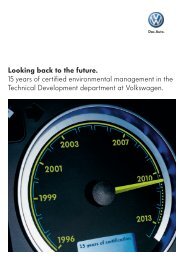(International Dismantling Information System ... - Volkswagen AG
(International Dismantling Information System ... - Volkswagen AG
(International Dismantling Information System ... - Volkswagen AG
Create successful ePaper yourself
Turn your PDF publications into a flip-book with our unique Google optimized e-Paper software.
of pyrotechnic components. For that reason the car industry has<br />
developed a standard ignition unit for pyrotechnic components.<br />
With this ignition unit, all electronic pyrotechnic components can<br />
be safely and reliably triggered in the course of recovery, thus<br />
excluding the possibility of uncontrolled ignitions.<br />
Fig. 15: Airbag system in the Polo V<br />
End-of-life vehicle recovery<br />
The recovery of end-of-life vehicles is carried out in three stages:<br />
<strong>Dismantling</strong>, shredding and the treatment of shredder residues, e.g.<br />
by means of the VW SiCon process.<br />
Stage 1: <strong>Dismantling</strong><br />
The recovery process starts with the handover of the end-of-life<br />
vehicle at a certified dismantler's facility. There the vehicle details<br />
are recorded, the certificate of destruction is issued for the vehicle's<br />
last owner, the battery is removed and all pyrotechnic components<br />
such as airbags, seat belt tensioners, battery safety terminal are<br />
triggered and thus made harmless. Then all the fluids (petrol,<br />
engine, gearbox and shock absorber oil, brake fluid, coolant, air<br />
conditioning system fluid) are drained off or sucked out. These are<br />
collected in separate containers and stored securely until<br />
subsequent recycling.<br />
Fig. 16: Removal of fuel, lubricants and other fluids using modern<br />
technology (photo: MAS Fahrzeugrecycling GmbH, Etzin)<br />
The dismantling process includes numerous components and<br />
subassemblies that are directly sold as used spares by the vehicle<br />
dismantler. Tyres and catalytic converters, glass and plastic parts<br />
are also removed. The removal of plastic parts for materials<br />
recycling is dependent on the basic economic conditions and the<br />
demand for recycled materials on the market.<br />
Seite 2




